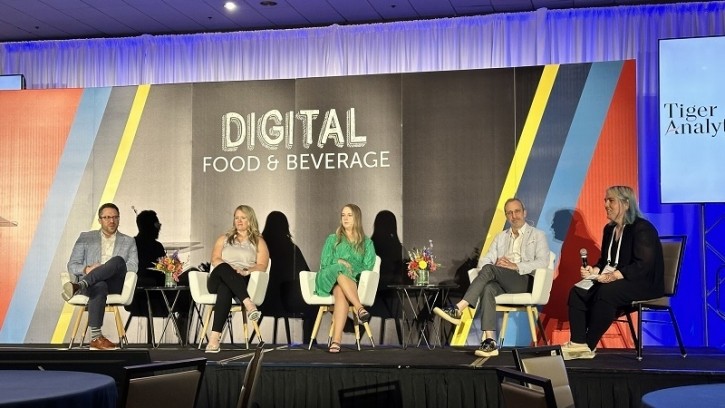General Mills, Tyson Foods share digital transformation strategies, challenges amid year of efficiency

Cross-department collaboration, strategically timing technology transitions and understanding where an organization is and going in its digital transformation strategy are three ways leading CPG companies are creating the future of omnichannel shopping — the blending of in-store and online shopping experiences — experts said during a panel moderated by FoodNavigator-USA’s Senior Correspondent Ryan Daily.
Representatives from General Mills, Tyson Foods and Constellation Brands also shared what technologies they are most excited about for the future.
The year of efficiency hits ecommerce spending
At the same time ecommerce teams are building new and engaging omnichannel experiences for consumers, many large companies have aggressively reduced their expenditures, partially through technology budget cuts and layoffs, in what has been dubbed a year of efficiency to boost balance sheets, boost stock performance and offset rising business costs.
Thus, many ecommerce teams are trying to create and enhance the digital customer experience with fewer resources, explained Andy Beilke, senior development manager of ecommerce strategy and capabilities at General Mills.
“[It is] very difficult to unlock growth via new or different capabilities when you need to reduce your budget by three, five, [or] seven percent, so we have not figured that out,” he added.
Cross-department collaboration is key: ‘Everyone believes in the potential of ecommerce’
Marketing, sales, ecommerce, IT and other departments in large CPG companies each have a role to play when it comes to creating new digital shopping experiences for consumers, Beilke elaborated.
Cross-department collaboration not only ensures that ecommerce technologies — whether that be a digital shopping platform or an omnichannel marketing software — are implemented properly, but that teams work towards a common goal, Beilke said.
“Everyone believes in the potential of ecommerce. Where they see growth, they see potential. But when it comes down to decision-making, that actually does not always reside with the executive team, that resides within the functional groups that … are collaborating,” he added.
Managing through migrations, integrations take ‘a frustrating long time’
Ecommerce professionals and marketers also are identifying expensive outdated technology that might hamper digital transformation progress, explained Jeffrey Meisel, VP and GM of DTC, wine and spirits for Constellation Brands.
While known for its alcoholic beverage brands, Constellation Brands has expanded its non-alcohol offerings and made several venture investments in non-alcohol brands, including TÖST and HOP WTR.
Meisel joined Constellation Brands through the company’s acquisition of Lingua Franca and helped integrate the teams and separate technology systems.
"[Technology migrations] take us a long time — a frustrating long time — because you have to do it within the cycles of the business. You can pretty much do that in the summer — a slower season for ecommerce business — or in the winter right after the holiday — that is it. If you miss a window, then you have to wait another six months. That can be very challenging for an organization, but it is worth it because we are able to get cleaner data, better reporting [and] better insights to our consumers,” Meisel said.
The importance of ‘understanding where you are ... in your digital journey’
Whether adding or removing technology, ecommerce teams are relying on metrics and key performance indicators (KPIs) to justify any changes to a company’s technology stack — the sum of the various technologies a company deploys — shared Ashton Dollins, marketing automation manager at Tyson Foods.
Dollins and her team gather data on how well ecommerce and marketing technology are performing to demonstrate the value of technology in building Tyson’s ecommerce business.
“My boss is great about understanding our tech stack and knowing what type of data we actually have available so that when he does make those asks [for new technology], he knows what to ask for,” Dollins said. “The biggest piece [of advice] I have is just understanding where you are at from a maturity standpoint in your digital journey. The last thing you want to do is have a goal or KPI that you cannot accurately measure until five years down the road.”
From AI to smart carts: What will the future of omnichannel shopping look like?
As many large CPG companies improve their backend technology, including migrating off old systems, they also are experimenting with new AI and in-store technologies designed to better understand consumer shopping behaviors.
Across the Digital Food and Beverage sessions, experts spoke on using AI technologies to create more engaging retail media, like photos and videos on ecommerce webpages, as well as cooking recipes in the case of General Mills, Beilke said.
General Mills also is conducting a pilot test of smart-cart — shopping carts with digital sensors and displays — which can provide a detailed experience of how and what a consumer shops for in a store, Beilke said.
"[Smart carts are] the ultimate consumer journey map experience. If you are a data nerd, you are geeking out about this. If you are an advertiser person, I can meet my consumer at the moment of truth. ... [Smart carts are] a great personification of all the values coming together,” he added.













